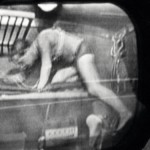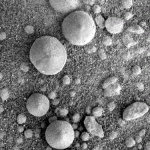
Rovers will help us better understand the Red Planet. Image: NASA
When the Mariner 9 space probe entered into its orbit around Mars in November 1971, it was met with cheers from the control centre in California, in the US. The probe had been on its way for six months, and it was the first ever to orbit Mars. A month later, hope had turned to dismay. Mars was bathed in the biggest dust storm ever observed, and the cameras caught nothing but a compact blanket of dust.
In December, as the storm began to wane, four dark patches emerged. As the atmosphere cleared, scientists realised what they were seeing — four giant craters at the peaks of four volcanoes, each between 65 and 80 kilometres wide. The largest loomed 27 kilometres high, nearly three times taller than Mount Everest. It was the first evidence of volcanoes on the planet. Scientific understanding of the Red Planet had suddenly changed.
Scientists were close to giving up
Six years earlier, in the summer of 1965, the first 21 close-ups of Mars were received, as the Mariner 4 space probe circled the planet. Disappointingly, the best images only revealed a crater-covered world very similar to the moon. Mariner 4 also measured the atmospheric density to be just 0.05 per cent of Earth’s but with 30 times as much carbon dioxide. Mars seemed dead, nothing like the planet imagined in films and novels. The images showed no traces of a dying world, where old civilisations had struggled to send the last of the planet’s water through large canals from the ice-covered poles down to the warmer desert regions. In actuality, the average temperature of the planet was -89° C, the temperature at which carbon dioxide freezes. The poles were not made of water ice; they were made of dry ice. There was no sign of life and little interesting geology. In 1969, when Mariner 6 and Mariner 7 surveyed more than 10 times the area of Mars as their predecessors, they confirmed these findings. The spacecraft also took 58 additional close-up photos and performed chemical analysis on the polar ice caps to verify that they were indeed made of frozen carbon dioxide. A set of photographs from Mariner 9 showed more of the planet’s topography. The four big volcanoes were only the beginning; many other landscapes appeared, not least of which was a giant nine-kilometre-deep canyon stretching just south of the equator. (Today, the canyon is called Valles Marineris in honour of the Mariner probes.)
The next discovery came as another surprise. Across the landscape, there were markings that looked like old dried-up riverbeds. But the atmospheric pressure, too low for water to flow freely on the surface, seemed to indicate that Mars once had a denser atmosphere and a warmer climate. Scientists continued to say that the planet must have been dead for billions of years, but these new images cast doubt on that interpretation.
Two very different hemispheres
In 1972, scientists were able to produce the first Mars globe, which showed how the planet had been misrepresented in the first images. Mariner 4, 6 and 7 mainly photographed the southern hemisphere, but when all of Mars was mapped, it became clear that there was a big difference between the crater-covered southern landscapes and the northern hemisphere, dominated by big volcanoes, canyons and flat lava plains. It also appeared that the planet had been covered not by rivers but by flooding.
The United States was not alone among nations attempting to explore Mars. From 1971 to 1973, six Russian space probes arrived on the planet, with limited results. Mars probes 3 and 6 landed on the planet but failed to work, and the other Russian probes only sent a few images back to Earth. The United States came to dominate the exploration of space, especially during the race to get to the Moon, during a time when space exploration generated much interest. NASA funded two highly sophisticated and costly probes, which were to land on Mars primarily to look for signs of life.
A controversial biological experiment
The two probes were named Viking 1 and Viking 2, and both consisted of an orbiter, which kept orbiting Mars, and a lander. In 1976, Viking 1 and 2 accomplished successful landings and subsequent experiments, but instead of solving mysteries, they left one behind that is still unsolved.
Viking 1 and 2 brought instruments meant to analyse the surface of Mars in search of traces of living organisms; the starting hypothesis was that organisms on Mars would behave more or less like those on Earth when given food and sunlight. The lab involved three different biological experiments. The first, called a pyrolytic release, entailed submerging Martian soil into a chamber containing radioactive carbon monoxide and carbon dioxide as well as Martian atmosphere for 120 hours. Because Mars’ atmosphere was made mainly of the latter, any microbes in the chamber would likely ingest the radioactive gas. Once the atmosphere was removed from the container, any remaining radioactive organic materials might indicate life. The second experiment, a gas exchange, involved dropping soil into a nutrient broth in a container, which was monitored with an instrument that measured the compositions of the gases inside. If the gases changed, it could indicate that microbes were digesting the nutrients.
The final experiment, called a labelled release, entailed dripping a small amount of radioactive liquid nutrients onto a soil sample and monitoring the gas in that container for radioactivity. None of the experiments found traces of organic substances in the surface itself, although this did not necessarily mean that the planet was devoid of life. This conclusion has been questioned by Dr Gilbert Levin, who was responsible for the labelled release experiment. Levin believed that there were signs of life in his samples, and the debate continues today, 35 years after the Viking landing.
The next step in the exploration of the Red Planet didn’t occur until two decades later, when the first tiny Martian rover, Sojourner, landed on the planet in 1997. Sojourner was small — just 0.6 metres long, 45 centimetres wide and 30.48 centimetres tall, and it didn’t get very far. But, for the first time in 20 years, it was possible to see the landscape of Mars as it would appear to a person standing on the surface. In the following years, space probes such as Mars Global Surveyor, Mars Odyssey, Mars Express and the giant Mars Reconnaissance Orbiter (MRO) arrived. MRO produced images that were about 10 times sharper than Viking’s.
Images show rock stratification
While Mariner 9 and Viking had photographed craters, volcanoes and evidence of flooding, images from the new space probes showed stratified deposits in many places, such as on the walls of the giant canyons and on crater rims of the old landscape to the south. Some of the strata included materials that usually only form in the presence of water, indicating that Mars may have had a past in which water played a major part.
In February 2010, MRO shot some very sharp images of the Gale crater, showing the clearest stratification that scientists have yet seen. At the bottom, there are strata of clay minerals, which can only be formed in the presence of running water. A little higher up the crater wall, there are strata in which clay is mixed with sulfates, which are formed under humid conditions; sulfate strata are deposited when the water evaporates. At the top, there are a number of strata that show no sign of having been formed under humid conditions. The crater wall is twice as high as the Grand Canyon, but not quite as steep, and the strata indicate that the planet is slowly drying up.
Traces of a watery world
Another key discovery indicates that Mars may not be totally dried up yet: the small grooves that can be seen in many places on crater walls. Here, it is evident that something flowed out of the crater wall and dug a trench reaching to the bottom. Such markings are also seen on Earth and are known to be made by water. On Mars, both the atmospheric pressure and the temperature are too low to allow water to flow freely on the surface. But it has been suggested that a mix of water and different salts could remain liquid long enough to make a trench before evaporating. At any rate, the many trenches indicate that right beneath the surface there may be considerable quantities of ice or water that may emerge from time to time. To be certain, humans must visit the surface of the planet. For seven years, the Opportunity rover has moved around and found several signs of water, as did its sister rover, Spirit, which lost communication with Earth in 2006. Opportunity has found indications that there were once saline lakes in the Meridian Planum, and slight markings of wave patterns have also been found in some places. Spirit landed in the Gusev crater because it was thought that the crater was once filled with water. Spirit roved across dry volcano rock for months and eventually found traces of a wet past on high ground before it got stuck permanently in a sand pile.
The next big step
Spirit and Opportunity were not sent to Mars to seek out traces of life; that task will fall to the next big rover, which will arrive on Mars in 2012. Curiosity is designed to travel large distances and will be programmed to look for microorganisms just like the Viking probes. The probe, called Sample Analysis at Mars (SAM), will be armed with an instrument designed to detect life. SAM will look for key chemical traces of life, including nitrogen, phosphorous, sulfur and carbon. SAM will also identify different isotopes, or flavours of a particular element, in the Martian atmosphere, which may give clues as to its evolution. Finally, it will look for methane, a gas that can be produced by microorganisms or geological processes such as volcanic activity. To generate a precise map of the methane-generating areas, NASA and the European Space Agency (ESA) will launch a new probe together in 2016 called ExoMars Trace Gas Orbiter (TGO), which will be designed by ESA and launched from the United States.
In 2018, two more rovers will follow, equipped to look for signs of life in the same was as Curiosity, but they will also be able to collect and analyse drill samples from the ground. If there is life, the chances of finding it are probably greater beneath the surface, where it would be protected from ultraviolet radiation and fluctuating temperatures.
In spite of all these efforts, it seems unlikely that we will have a final answer to the question of whether or not there is life on Mars based on data from probes. Their observations will be interpreted by scientists on Earth, and they may be debated. In order to have a definite answer, there is no avoiding the next step: sending humans to the Red Planet. Are we ready for it?
Check out this video explaining how Curiosity will land on the Red Planet:






